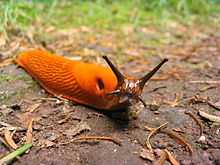Arion (gastropod)
| Arion | |
|---|---|
 | |
| Arion rufus | |
| Scientific classification | |
| Kingdom: | Animalia |
| Phylum: | Mollusca |
| Class: | Gastropoda |
| (unranked): | clade Heterobranchia clade Euthyneura |
| Superfamily: | Arionoidea |
| Family: | Arionidae |
| Genus: | Arion Férussac, 1819[1] |
| Species | |
|
See text | |
Arion is a genus of air-breathing land slugs in the family Arionidae, the roundback slugs. Most species of this Palearctic genus are native to the Iberian Peninsula.[2]
Species can be difficult to distinguish from one another upon cursory examination, because individuals of a species can vary in color and there are few obvious differences between taxa.[3] The color of an individual can be influenced by its diet.[4]
Some Arion are known as pests, such as A. lusitanicus auct. non Mabille (= A. vulgaris), which damages agricultural crops and ornamental plants, and A. rufus, a familiar garden pest.[5] Arion slugs are often transported internationally in shipments of plant products and mushrooms.[6]
Species
There are approximately 40 species in the genus.[4]
Species include:
- Arion ater – black slug
- Arion circumscriptus – brownbanded arion
- Arion distinctus Mabille, 1868
- Arion fasciatus
- Arion flagellus
- Arion fuscus
- Arion hortensis Férussac, 1819 – small striped slug
- Arion intermedius Normand, 1852 (syn. Arion alpinus Pollonera, 1887[7]) – hedgehog slug
- Arion lusitanicus
- Arion obesoductus (syn. Arion alpinus auctt. non Pollonera, 1887[7])
- Arion occultus
- Arion owenii
- Arion rufus – red slug
- Arion silvaticus
- Arion simrothi
- Arion subfuscus
- Arion transsylvanus Simroth, 1885[8]
- Arion vulgaris (syn. Arion lusitanicus auct. non Mabille) – Spanish slug
Also included
- Arion vejdorskyi, a taxon with unclear taxonomic position
References
- ↑ Férussac, A. E. and G. Deshayes. 1819-1851. Histoire naturelle générale et particulière des mollusques terrestres et fluviatiles, tant des espèces que l'on trouve aujourd'hui vivantes, que des dépouilles fossiles de celles qui n'existent plus; classés d'après les caractères essentiels que présentent ces animaux et leurs coquilles. pp. Tome 1: 8 + 184 pp.; Tome 2 (1): 402 pp.; 2 (2): 260 + 22 + 16 pp.; Atlas 1: 70 pl.; Atlas 2: 166 + 5 pl.. Paris. (J.-B. Bailliere).
- ↑ Quinteiro, J., et al. (2005). Phylogeny of slug species of the genus Arion: evidence of monophyly of Iberian endemics and of the existence of relict species in Pyrenean refuges. Journal of Zoological Systematics and Evolutionary Research 43(2), 139-48.
- ↑ Skujienė, G. and M. Soroka. (2003). A comparison of different DNA extraction methods for slugs (Mollusca: Pulmonata). Ekologija 1, 12-16.
- ↑ 4.0 4.1 Jordaens, K., et al. (2001). Food-induced body pigmentation questions the taxonomic value of colour in the self-fertilizing slug Carinarion spp. Journal of Molluscan Studies 67(2), 161-67.
- ↑ Soroka, M., et al. (2008). Distribution and genetic diversity of the terrestrial slugs Arion lusitanicus Mabille, 1868 and Arion rufus (Linnaeus, 1758) in Poland based on mitochondrial DNA. Folia Biologica 57(1-2), 1-2.
- ↑ Barr, N. B., et al. (2009). Application of a DNA barcode using the 16S rRNA gene to diagnose pest Arion species in the USA. Journal of Molluscan Studies 75(2), 187-91.
- ↑ 7.0 7.1 Manganelli, G., et al. (2010). The status of Arion alpinus Pollonera 1887, and re-description of Arion obesoductus Reischütz 1973 (Gastropoda, Arionidae). Journal of Conchology 40, 269-76.
- ↑ Jordaens, K., et al. (2010). Arion transsylvanus (Mollusca, Pulmonata, Arionidae): rediscovery of a cryptic species. Zoologica Scripta 39(4), 343-62. doi:10.1111/j.1463-6409.2010.00425.x.
External links
| Wikimedia Commons has media related to Arion. |